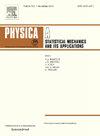二元复杂度-熵平面上的加密货币时间序列:复杂系统视角下的排序效率
IF 2.8
3区 物理与天体物理
Q2 PHYSICS, MULTIDISCIPLINARY
Physica A: Statistical Mechanics and its Applications
Pub Date : 2025-06-04
DOI:10.1016/j.physa.2025.130699
引用次数: 0
摘要
我们报告了专为二元序列和结构设计的定制复杂性熵平面的首次应用。我们通过考虑市值最大的加密货币(不包括稳定币)的每日上涨/下跌价格波动来做到这一点,这些加密货币的价值约占加密市场总市值的90%。我们专注于价格运动的基本要素,将它们与有效市场假说的数学基础相关的随机游走的主要特征进行比较。根据每个加密货币在二元复杂性-熵平面(BiCEP)上的位置,我们定义了一个低效率得分I.基于BiCEP分析的结果,我们用统计测试证实了这一点,表明只有柴犬(SHIB)显着低效,而大多数加密货币交易在接近高效的条件下运行。总的来说,我们基于i的排名暗示,加密货币的设计和共识架构与效率的相关性至少与通常在评估金融工具(即规范法定货币)效率时考虑的特征一样。最后,这组结果支持了二元复杂度分析的有效性。本文章由计算机程序翻译,如有差异,请以英文原文为准。
Cryptocurrency time series on the Binary Complexity-Entropy Plane: Ranking efficiency from the perspective of complex systems
We report the first application of a tailored Complexity-Entropy Plane designed for binary sequences and structures. We do so by considering the daily up/down price fluctuations of the largest cryptocurrencies in terms of capitalization (stable-coins excluded) that are worth approximately of the total crypto market capitalization. We focus on the basic elements of price motion, comparing them to the backbone features of a random walk associated with the mathematical underpinnings of the Efficient Market Hypothesis. From the location of each crypto on the Binary Complexity-Entropy Plane (BiCEP), we define an inefficiency score, . The results based on the BiCEP analysis, which we substantiate with statistical testing, indicate that only Shiba Inu (SHIB) is significantly inefficient, whereas the majority of cryptocurrency trading operates in close-to-efficient conditions. Broadly, our -based ranking hints that the design and consensus architecture of a crypto is at least as relevant to efficiency as the features that are usually taken into account in the appraisal of the efficiency of financial instruments, namely canonical fiat money. Lastly, this set of results supports the validity of the binary complexity analysis.
求助全文
通过发布文献求助,成功后即可免费获取论文全文。
去求助
来源期刊
CiteScore
7.20
自引率
9.10%
发文量
852
审稿时长
6.6 months
期刊介绍:
Physica A: Statistical Mechanics and its Applications
Recognized by the European Physical Society
Physica A publishes research in the field of statistical mechanics and its applications.
Statistical mechanics sets out to explain the behaviour of macroscopic systems by studying the statistical properties of their microscopic constituents.
Applications of the techniques of statistical mechanics are widespread, and include: applications to physical systems such as solids, liquids and gases; applications to chemical and biological systems (colloids, interfaces, complex fluids, polymers and biopolymers, cell physics); and other interdisciplinary applications to for instance biological, economical and sociological systems.

 求助内容:
求助内容: 应助结果提醒方式:
应助结果提醒方式:


